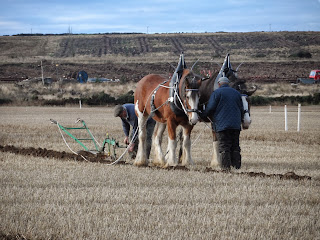Choreography of Horse and Plough
It seems simple enough--a man, a plough, two horses, an open field. Only a moment's watching made me realize the complex choreography required. Each of the elements contained so many variables.
The Horses
A matched pair of horses is a miracle in its own right. Matching in size is not essential nor colour unless for the particular pleasure of the aesthetics, but temperaments must match.
After the first run, one horse is always walking in a furrow; the other on untilled land. The evenness of their pacing, responses to word commands, and the precise stepping as they navigate a smooth turn to prepare for the next row are all a joy to watch. I laughed to think that the fancy stepping of the Lippizaner horses for which they are renown used to be a commonplace for plough horses.
The exquisite equipment adorning the horses reflects their importance and their status in the community. I heard about a man who was not wealthy enough to have two sets of harness, so he used his match harness for working the fields but kept it carefully wrapped in jute so that it stayed in good nick.
Some of these horses have traveled nearly the length of Scotland to get here for this two-day event. It is the first time the Scottish ploughing match has been held in Caithness. If the horses are tired, they give no indication of it, but several of the human participants or audience comment on how far they had to travel. There is a psychological barrier as well as a geographical one to travelling to the northern edge of Scotland. Nearby Orcadians, however, came to Caithness is force and probably were delighted with a short ferry crossing.
The Plough
This is a Ransom plough. It has wheels, so it required more complex manufacture than the wheel-less swing plow, which could be made by a local blacksmith back when blacksmiths were local.
Nearly every row of ploughing required some tinkering with the equipment. It reminded me of my old Sears sewing machine and adjusting the tension for an even thread feed.
The swing plough had no wheels, so I suspect it required more effort by the ploughman to keep it both straight and at the right depth. Judging was based on several criteria including how straight and even the furrow was (and at the right depth), how the soil turned out as the plough cut through the barley stubble, how smooth the turns were, and how clean and even both the beginning and end of each row. Both man and horse had to be careful not to step on the overturned earth.
If you had any doubts that the ploughmen work as hard as the horses, this shot belies that. None of the competitors was young,although the men holding the horses seemed a bit younger. Only a bit. A friend of mine who, like me, wants the world to be a more sustainable place, was watching with me for awhile.
Seamus Heaney, the poet whose translation of Beowulf begins, 'Well...' modeled his idea of epic recitals on the men of his youth who would come into the kitchen after a day of ploughing and announce, 'Well, that's that field ploughed.' Now I have a better understanding of both ploughing and epic poetry.









2 Comments:
Oh I so wish I had been there! the horses look so good and the skill is clear even in the photos, Mind you it wasn't warm that day so maybe I was better indoors!
Your close photo framing of neck to harness jewelry over the back to hindquarters captures everything about the animal, its strength, its deep musty smell, and its human partnership. I love it.
Post a Comment
<< Home